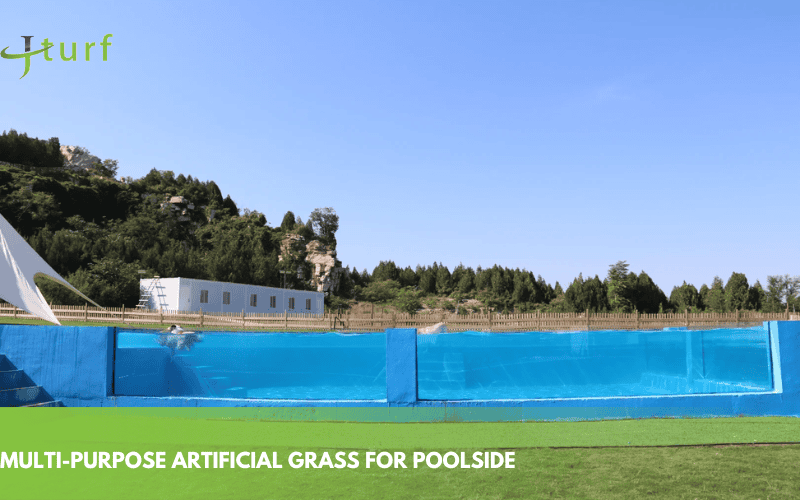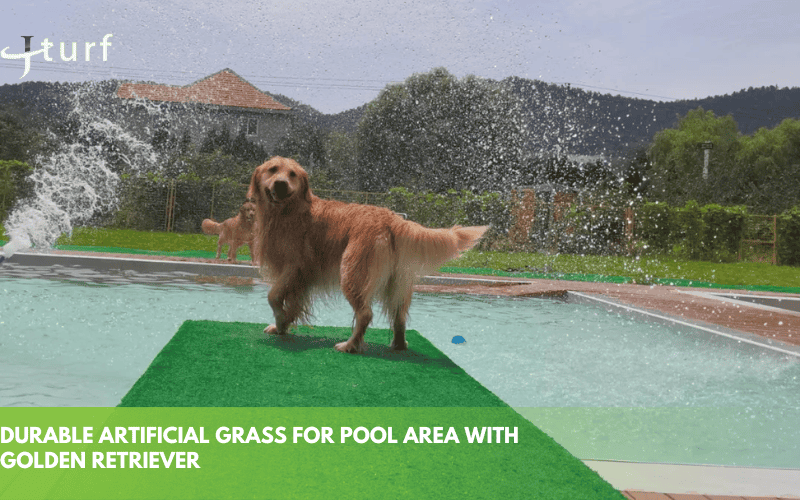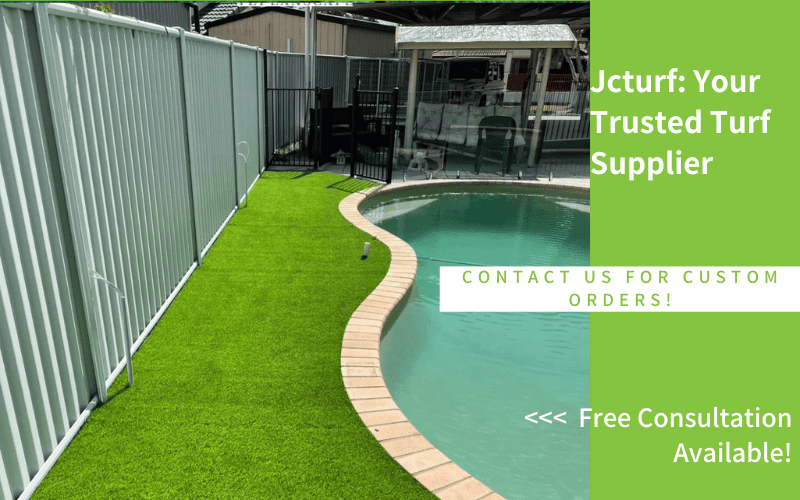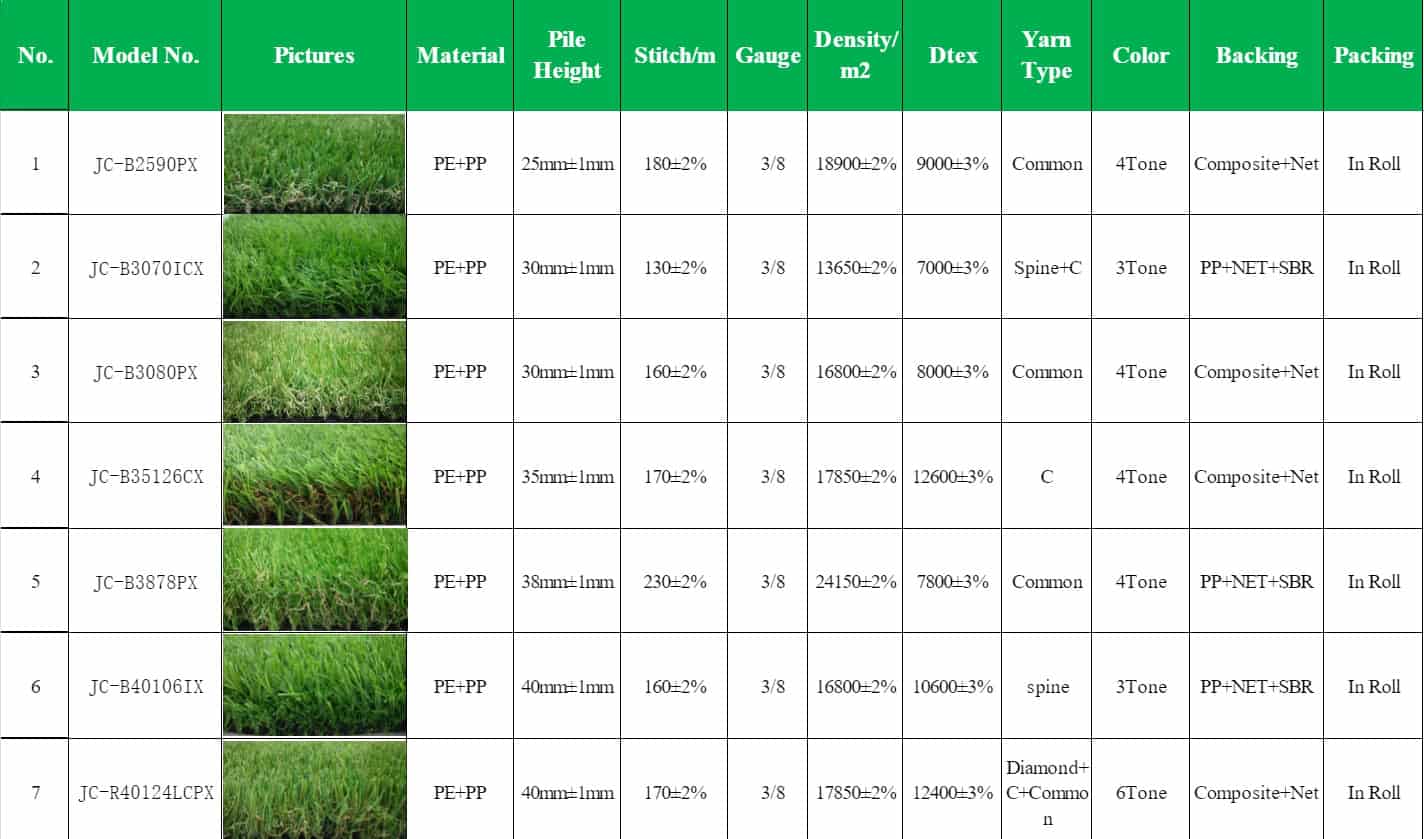We’ll explore the pros and cons of artificial grass around pools, its various applications, creative design ideas, and the costs involved. We’ll also guide you on how to install and maintain it to keep your pool area looking pristine. Plus, we’ll help you make the right choice before making your purchase.
Is Artificial Grass Good Around a Pool?
Yes, artificial grass is a great choice for pool areas. It offers several benefits that make it ideal for this setting. Unlike natural grass, it doesn’t require constant mowing, watering, or fertilizing. It also provides a safe, slip-resistant surface that helps reduce the risk of falls, especially when the area is wet. Additionally, artificial grass maintains its vibrant green color throughout the year, enhancing the aesthetic of your poolside.
Does Water Damage Artificial Grass?
No. Artificial grass is designed to withstand water, including pool water, rain, or splashes. Its water-resistant materials and drainage system allow water to pass through and drain away. While heavy flooding may cause infill displacement or base damage, light rain or normal watering won’t harm it.
Is Artificial Grass Water-Resistant?
Yes, artificial grass is designed to handle moisture effectively. It is water-resistant and features a permeable backing or drainage holes that allow water to pass through easily, preventing puddles and ensuring the area remains dry and functional.
Can Water Pass Through Artificial Grass?
Yes. The majority of high-grade artificial turf is crafted with a perforated backing, enabling water to drain rapidly and effectively. This helps prevent water from pooling on the surface, which could otherwise lead to the growth of mold or mildew.
Will Chlorine Damage Artificial Grass?
No. Artificial turf is made with materials that are resistant to pool chemicals, including chlorine. While prolonged exposure to high chlorine levels might cause discoloration, regular rinsing and protective coatings can help prevent this.
Can You Put a Swimming Pool on Artificial Grass?
Yes, you can place a swimming pool, including inflatable or above-ground pools, on artificial grass. It is durable, handles water exposure well, and provides excellent drainage. For above-ground pools, prepare the ground properly, consider using shorter-pile grass, and add a protective layer to maintain the area underneath. Professional advice is recommended for proper installation.

Pros and Cons of Artificial Grass Around Pools
When considering artificial grass for your pool area, it’s important to evaluate both its benefits and drawbacks. Here’s a straightforward breakdown to help you make an informed decision.
Pros of Artificial Grass Around Pools
Low Maintenance: No Mowing, Watering, or Fertilizing Required
- Artificial grass requires minimal upkeep, which is one of its biggest advantages. Unlike natural grass, you won’t need to spend time mowing, watering, or applying fertilizers. This is especially beneficial around pools, where natural grass can get soggy and muddy.
Durability: Artificial turf is made to endure the harsh conditions often found around pools.
- Pool Water: Resistant to damage from chlorine or saltwater.
- UV Protection: Designed to prevent fading or deterioration from direct sunlight.
- Heavy Foot Traffic: Can withstand frequent use without showing wear and tear.
- Better Drainage: Equipped with drainage systems that allow water to drain away quickly, preventing puddles and mud.
Consistent Aesthetic: No more worrying about patchy or brown grass during dry spells or colder months. Artificial grass stays green and vibrant year-round, providing a consistently beautiful poolside landscape. It can also be customized to fit any pool area shape and size, offering a wide range of design options.
Safety Features: Slip-Resistant and Comfortable
- Non-Slip Surface: Artificial grass provides better traction than wet concrete or natural grass, reducing the risk of slips and falls, especially for children.
- Soft Underfoot: It’s durable yet soft, offering a comfortable surface for walking and playing.
- No Mud or Debris: Unlike natural grass, artificial turf doesn’t track mud, grass clippings, or debris into the pool, keeping the area cleaner and safer.
Additional Benefits:
- Water Conservation: Since artificial grass doesn’t require watering, it helps conserve water—a significant advantage in areas prone to drought.
- Fewer Bugs: Artificial grass doesn’t attract insects like natural grass, reducing the bug population around the pool area.
Cons of Artificial Grass Around Pools
Heat Buildup: Artificial grass can absorb heat from the sun, making it uncomfortably hot to walk on during peak sunlight hours. While this is a common concern, the heat issue can be mitigated with:
- Cooling Infill: Special infill materials can help lower the temperature.
- Shaded Areas: Adding umbrellas or shade structures around the pool can reduce the heat buildup.
Initial Investment: Higher Upfront Costs Compared to Natural Grass or Other Materials.
- While artificial grass can save you money in the long run, the initial cost is higher than planting natural grass or using traditional poolside materials.
- Though the upfront cost is higher, the savings in water, maintenance, and lawn care over time often outweigh the initial investment.
Low Maintenance: Artificial grass requires less upkeep than natural grass, eliminating the need for mowing, watering, and fertilizing. However, it still requires regular brushing to prevent matting, cleaning to remove debris, and prompt attention to pet waste to prevent odors and stains.
Durability and Safety: Artificial turf is resistant to chlorine and UV rays, durable under heavy foot traffic, and designed with drainage systems to prevent puddles. It provides better traction than wet concrete, but can become slippery if not properly maintained.
Consistent Aesthetic: Artificial grass remains green and vibrant year-round, though some find it less natural-looking due to blade uniformity. It can be customized to fit any pool area shape and size.
Environmental Impact: Artificial grass conserves water but is made from synthetic materials, contributing to its carbon footprint and potential urban heat islands. Both artificial and natural grass have environmental impacts.
Potential for Damage: While durable, artificial grass can be damaged by sharp objects, excessive heat, or improper installation. Proper maintenance and installation are crucial for longevity.
Additional Considerations: Infill materials aid drainage and stability but can be tracked into pools if not properly maintained.

Applications of Artificial Grass Around Pools
Artificial grass offers versatile applications around pools. Let’s dive into how this versatile material can be applied across different pool areas.
Artificial Grass for Swimming Pools on Concrete
Artificial grass works well on concrete pool decks, providing a softer, slip-resistant surface. It enhances safety and comfort while offering a natural look. Installation is simple, using adhesive or tape, and requires minimal maintenance compared to natural grass.
Artificial Grass for Swimming Pools on Balconies
For balcony pools, artificial grass is lightweight, easy to install, and requires little upkeep. Choose turf with good drainage to prevent water from pooling and damaging the surface below. This transforms small, elevated pool spaces into a comfortable and stylish area.
Artificial Grass for Swimming Pools to Prevent Erosion
Artificial grass helps stabilize the soil around the pool, preventing erosion caused by water runoff or heavy foot traffic. It’s ideal for sloped areas or places prone to soil movement, ensuring your poolside remains neat and functional.
Artificial Grass for Swimming Pools to Prevent Algae
Algae growth around pools is minimized with artificial grass, as it doesn’t retain moisture like natural grass. This reduces the conditions that promote algae, helping keep the poolside cleaner and safer with minimal maintenance.
Artificial Grass for Swimming Pools with Drainage
For pool areas, good drainage is essential to prevent water from pooling. Artificial grass with drainage capabilities allows water to pass through quickly, maintaining a dry, safe environment and preventing mold or mildew buildup.
Artificial Grass for Swimming Pools with UV Protection
UV protection is crucial for artificial grass exposed to sunlight. Turf with UV resistance maintains its vibrant color and durability, ensuring your poolside area stays attractive even with prolonged sun exposure.
What is the Best Grass for Around a Pool?
JCturf offers high-quality artificial grass perfect for pool areas, designed to resist chlorine and saltwater while maintaining vibrant color. With excellent drainage, UV protection, and a non-slip surface, our turf ensures a safe, durable, and low-maintenance poolside that stays beautiful year-round.
Artificial Grass Around Pool Ideas
Artificial grass brings a lot of creativity to your pool area. It not only enhances safety and comfort but also adds style and functionality. Whether it’s for relaxation, play, or practicality, you can transform your poolside with a variety of artificial grass applications.
Artificial Grass for Swimming Pools with Fish
Artificial grass enhances the look of fish ponds around your pool, providing a clean and low-maintenance surface. It reduces mud and algae buildup, making the area easier to maintain while complementing the serene beauty of the water.
Artificial Grass for Swimming Pools with Decks
Combining artificial grass with pool decks creates a soft, comfortable surface that contrasts nicely with hard materials. It offers a slip-resistant area for walking or lounging, blending well with wood, stone, or tile decks for a stylish, functional outdoor space.
Artificial Grass for Swimming Pools with Slides
For pools with slides, artificial grass adds safety and comfort. The soft, non-slip surface cushions landings, making the area safer and more enjoyable for users, while complementing the playful atmosphere around the slide.
Artificial Grass for Swimming Pools with Dogs
Artificial grass is perfect for pet owners, as it is durable, easy to clean, and resistant to wear from pets. It doesn’t get muddy and dries quickly, making it an ideal, low-maintenance surface around the pool for both pets and owners.
Artificial Grass for Swimming Pools with Tray
Pairing artificial grass with trays or platforms around your pool area helps keep poolside items organized while maintaining a neat, stylish look. The turf adds a natural touch while providing a practical, clean space for storing pool accessories.
Artificial Grass for Swimming Pools with Putting Green
Artificial grass can be used to create a putting green around your pool, offering a smooth, consistent surface for golf practice. This multifunctional space lets you relax by the pool while working on your golf game.
Artificial Grass for Swimming Pools with Padding
Artificial grass with added padding offers extra comfort and safety around the pool. The cushioned surface reduces impact, making it perfect for families with children or elderly individuals, creating a secure and comfortable environment.
Artificial Turf Around Pool Cost
Artificial turf typically costs between $15 to $19 per square foot. Lower-end options are cheaper but may lack durability and realism, while premium options offer better UV resistance, drainage, and longer lifespan. For an average pool area, you can expect to spend between $2,000 and $7,000, depending on the size and quality of the turf.
Factors Affecting Cost
Turf Quality: Higher-quality turf costs more but offers better performance, with features like enhanced UV protection and improved durability, making it ideal for poolside areas.
Area Size: Larger pool areas will require more turf, leading to higher costs. Be sure to measure the space accurately to get an accurate estimate.
Installation Complexity: Installation costs will vary depending on the terrain and preparation required. Installation costs typically range from $2 to $8 per square foot. Simple installations are less expensive, while sloped areas or additional drainage solutions will increase costs.
Long-Term Savings: Although artificial turf has a higher initial cost, it saves money in the long run. You’ll avoid ongoing costs for watering, mowing, and fertilizing, and the turf’s durability ensures it lasts for many years without needing replacement. These savings make artificial grass a smart investment for pool areas.

How to Install Artificial Grass Around a Pool?
Putting artificial grass around your pool is a really easy job, and it makes the whole area look way better and work better too.
- Prepare the Area: Clear the poolside of debris, weeds, or old turf. Ensure the surface is clean and flat. When installing on soil, eliminate any uneven areas and contemplate placing a weed – barrier fabric to inhibit weed growth.
- Level the Ground: Use a rake to level the soil and fill any low spots to ensure a smooth, even surface.
- Create a Drainage Layer: Put down a base layer of crushed stone or decomposed granite. This will help water drain better and stop it from forming puddles. After that, make sure to compact the base really firmly.
- Lay the Turf: Roll out the turf, trimming it to fit around the pool edges. Leave a small gap for expansion and cut the turf neatly around the pool.
- Secure the Edges: Use landscape staples or adhesive to secure the edges. For concrete borders, apply outdoor adhesive to attach the turf.
- Add Infill: Spread an even layer of infill like sand or rubber granules to keep the fibers upright and secure the turf.
- Final Touches: Sweep the area clean and check the edges to ensure everything is secure. Your artificial grass poolside is now ready to enjoy!
What to Put Under an Inflatable Pool on Grass?
To protect your lawn and inflatable pool, lay a heavy-duty tarp or pool-specific ground cloth beneath the pool. This prevents punctures and reduces moisture buildup that can harm the grass. Ensure the tarp extends beyond the pool’s edges and is laid flat without wrinkles.
For extra cushioning and leveling, add a 1-2 inch layer of sand or foam padding over the tarp. Sand helps distribute weight evenly, while foam panels provide insulation and comfort, especially on uneven ground. Secure foam seams with tape for stability.
Before setup, clear the area of sharp objects and ensure the ground is level. For damp areas, add gravel under the tarp to improve drainage.
Maintenance of Artificial Grass for Swimming Pools
Keeping the artificial grass surrounding your pool well – maintained is crucial for ensuring it remains in excellent condition, consistently enhancing the beauty and practicality of your poolside area.
Rinse Regularly: Use a garden hose weekly to remove dirt, dust, and pool chemicals, increasing frequency during peak swimming season.
Clean Spills: For general stains, use mild soap and water; for oil-based stains, use mineral spirits; for sticky substances like gum, harden with ice and scrape gently before rinsing. Avoid harsh chemicals or abrasive tools.
Brush and Groom: Sweep away debris with a soft brush or leaf blower, and brush fibers upright with a push broom to maintain appearance.
Neutralize Odors: Use enzyme-based cleaners for pet odors and urine to break down smells.
Cool in Hot Weather: Spray the turf with water during hot weather to reduce heat.
Maintain Infill: Check and maintain infill material (like silica sand) if required for your turf type.
Avoid Damage: Do not use power washers, harsh chemicals, or place heat sources like BBQs on the turf.
What Should You Not Put on Artificial Grass?
To keep your artificial grass looking its best, avoid the following:
- Avoid heat sources like barbecues, fire pits, hot coals, or fireworks, as they can melt the fibers.
- Keep harsh chemicals, oil-based paints, gasoline, chewing gum, oils, and adhesives away to prevent damage.
- Sharp objects like tools, gravel, and metal rakes can tear the turf, while heavy items can cause indentations if not supported.
- Avoid glass that could shatter and prolonged use of tarps or plastic pools, which can trap moisture and harm the backing.
Considerations Before Installing Artificial Grass Around Your Pool
Before installing artificial grass around your pool, consider a few important factors to make the right choice for your space and needs.
Budget: Artificial grass can vary in price depending on quality. Higher-end options offer more durability and a more natural appearance, while budget options still provide reliable performance.
Pool Type: The type of pool you have will influence your turf choice. For concrete pool decks, opt for grass that’s easy to install and resistant to heat. Above-ground pools may require more flexible turf with better drainage.
Aesthetic Preferences: Consider color, pile height, and texture that match your pool’s design. Denser, greener grass creates a luxurious look, while shorter pile height is better for low-maintenance, functional areas.
By factoring in these elements, you’ll choose the right turf for both functionality and visual appeal.
High-Quality Artificial Grass for Pools from Leading Manufacturers
As a leading supplier and manufacturer of artificial grass, JCturf offers high-quality turf designed to transform your pool area. Our products are built to withstand pool chemicals, heavy foot traffic, and extreme weather conditions, providing a safe, low-maintenance, and beautiful space year-round.
With excellent drainage, UV protection, and a non-slip surface, our artificial grass ensures your poolside remains clean and visually appealing. Let us help you create the perfect poolside environment!


